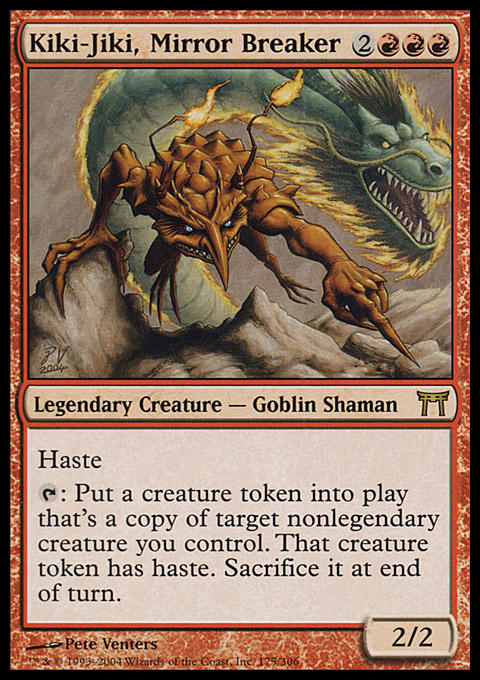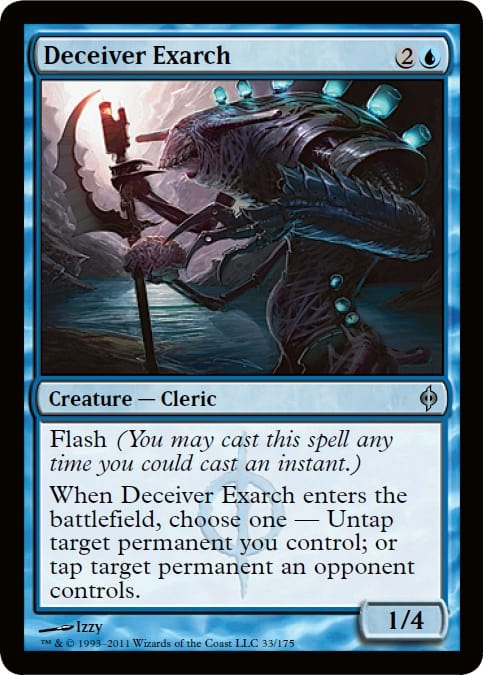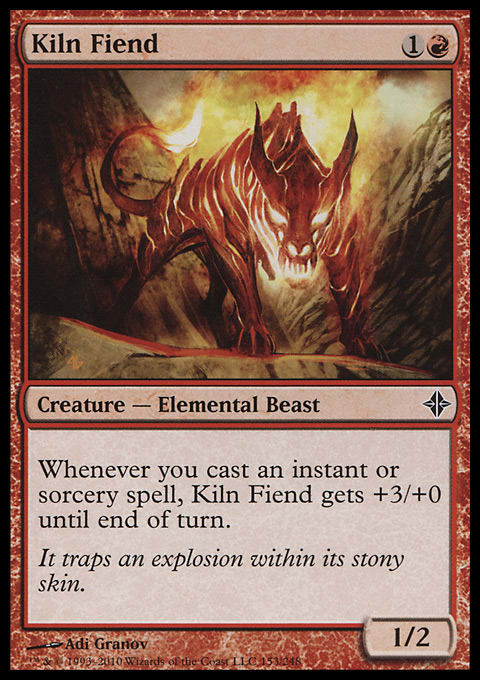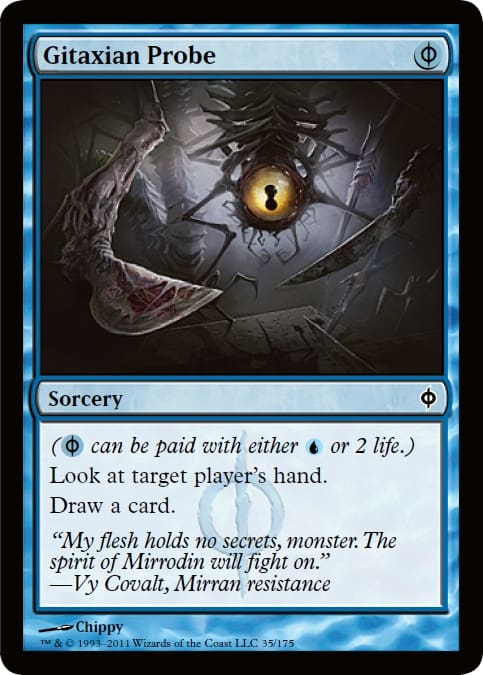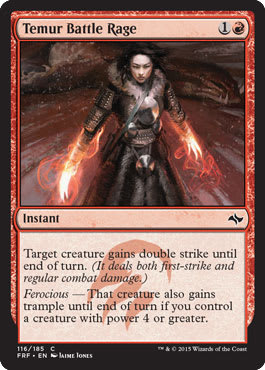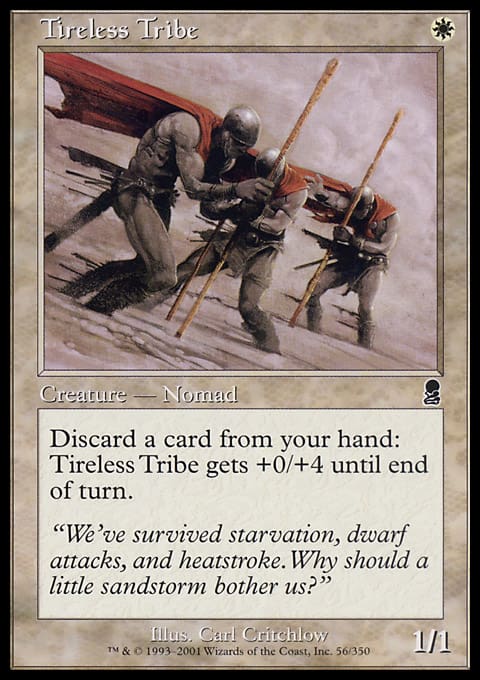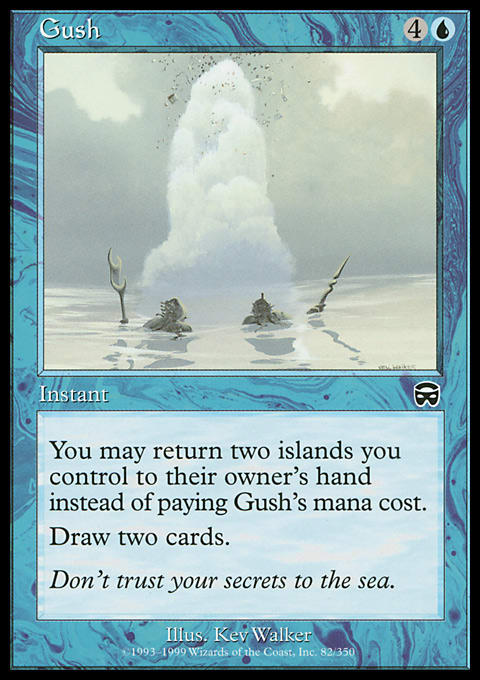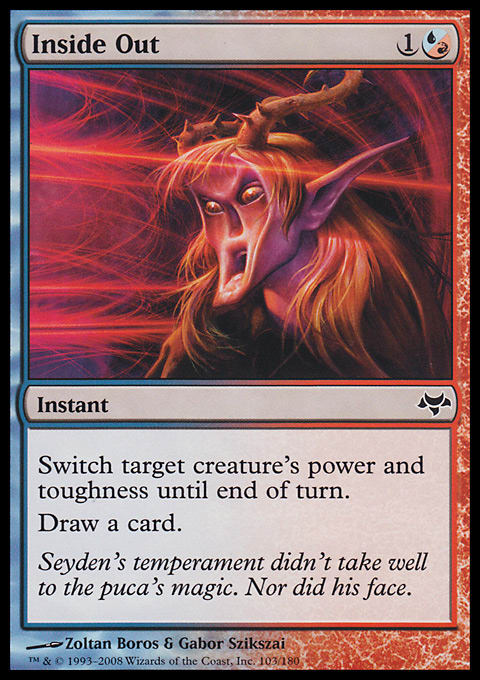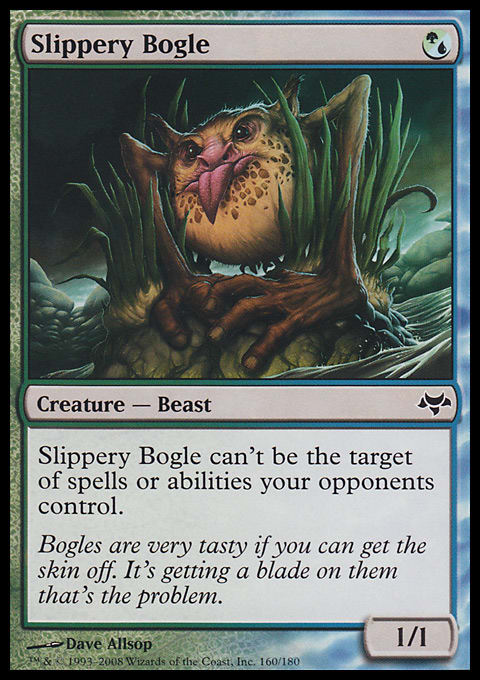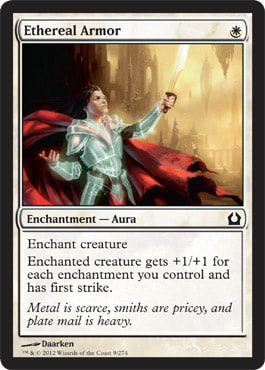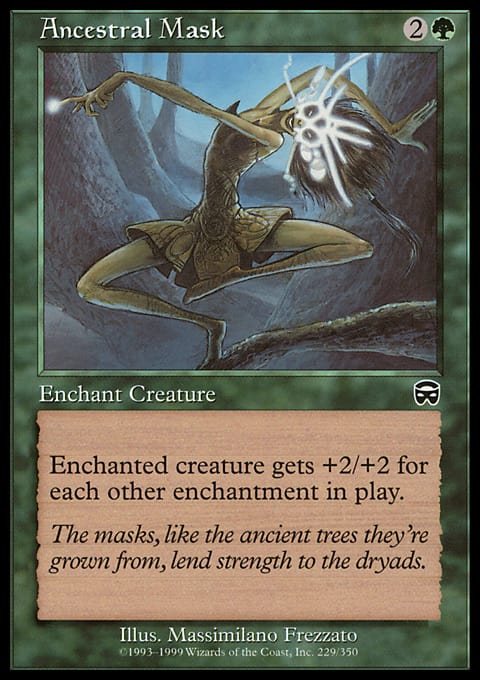In the great food chain of the Magic metagame, there exists certain decks whose goal is to fundamentally break the development speed of Magic by assembling A + B combinations that either win the game on the spot, or put their pilot in such an advantaged position that their chance to win improves dramatically.
In terms of raw speed, combo decks are the one style of deck that can outrace a good, linear Aggro deck. But because of the fragility necessary of needing certain moving pieces to fit together in order to win, they are much more easily disrupted than Aggro decks whose strategies rely much more on redundancy than finding just the right cards to win.
Probably the most famous Combo deck in Magic, Splinter Twin, used a two card combination to win on the spot by creating "Infinite Faeries" who, thanks to haste, could win the game using just one combat step by attacking with an arbitrarily large number of attackers. But the resilience of the Splinter Twin deck was that it could win with a number of mix-and-match pieces including one of the "A" components of Splinter Twin or Kiki-Jiki, Mirror Breaker plus one of the "B" components of Deceiver Exarch or Pestermite. Or as we often observe in Magic Cubes, one can also win with additional "B" components like Restoration Angel, Zealous Conscripts or even sub-optimal choices like Village Bell-Ringer and Midnight Guard.
While it may seem unfair to win so easily with a two card combo, especially one that can be initiated on the opponent's end step, observe that even the Splinter Twin deck can fall apart due to any manner of disruptive elements. You can Path To Exile the creature; you can remove the Splinter Twin enchantment; you can have the token creatures enter play tapped using Authority of the Consuls or punish the user for their activations using Harsh Mentor. You can Fog their attack. Or you can just have them discard one of their key pieces using Thoughtseize or Duress. In any of these scenarios the Combo player still has the means in their deck to threaten to win, but you have broken their A + B synergy to win on the spot.
Pauper as a format is ripe with Combo decks, many of which can either win on the spot, or put their caster so far ahead that their chance of winning feels significantly improved. While there is both a history of and a certain style of control decks even present today in Pauper that win via "slow combos", I want to focus on the Combo decks that represent that fundamental metagame axis of Combo decks: decks that can win faster than linear Aggro decks.
First up is the most persistent successful Combo deck in Pauper, Izzet Blitz
Izzet Blitz -- Pauper | pinato, 5-0 in Pauper League 07-11-2018
- Creatures (14)
- 3 Augur of Bolas
- 3 Delver of Secrets
- 4 Kiln Fiend
- 4 Nivix Cyclops
- Instants (17)
- 1 Dispel
- 2 Brainstorm
- 2 Mutagenic Growth
- 3 Apostle's Blessing
- 3 Gush
- 3 Lightning Bolt
- 3 Temur Battle Rage
- Sorceries (12)
- 4 Gitaxian Probe
- 4 Ponder
- 4 Preordain
- Lands (17)
- 3 Mountain
- 9 Island
- 3 Evolving Wilds
- 2 Great Furnace
- Sideboard (15)
- 3 Pyroblast
- 2 Electrickery
- 2 Flaring Pain
- 2 Hydroblast
- 2 Spell Pierce
- 2 Stormbound Geist
- 1 Dispel
- 1 Gut Shot
The A + B of Izzet Blitz is to combine creatures that care about instants and sorceries being cast with a glut of instants and sorceries, particularly ones that cantrip, or dig toward additional cards when they are being cast.
Izzet Blitz has a "Goldfish" speed of 3 turns, meaning that undisrupted, it has the power to deal 20 damage by turn three by playing a Kiln Fiend on turn two followed by a number of combinations of three spells on turn three, such as Preordain, Gitaxian Probe, and Temur Battle Rage. Losing to Izzet Blitz on Turns 4 or 5 is not uncommon at all.
Observe first the common Combo deck elements of the Izzet Blitz deck: card selection tools, like Ponder and Preordain, a low land count, fewer actual threats than most creature-based decks, and a "kill" card, in this case, Temur Battle Rage. This deck can actually win without its kill card just by threatening for a kill and chipping in for 3, 4 or 7 at a time. Or it can do 20 in one punch.
The sideboard of this deck, like many Combo decks, is less focused on disrupting one's opponent's strategy as disrupting their counter strategy against one's own deck. It has cheap counters in cards like Pyroblast, Hydroblast, and Dispel and Spell Pierce, a way to combo through damage prevention in Flaring Pain, which is important against Prismatic Strands and Moment's Peace, a means to combat Chainer's Edict style attrition decks in Stormbound Geist, and ways to combat Spellstutter Sprite in Electrickery and Gut Shot. In sum, the sideboard of Izzet Blitz is solely focused on how other decks come prepared in their sideboard to disrupt Izzet Blitz combo, and the deck tries to provide counter-answers to their disruption.
Tireless Tribe Combo -- Pauper | unicornparadise, 6-1 in Pauper Challenge 07-08-2018
- Creatures (6)
- 2 Augur of Bolas
- 4 Tireless Tribe
- Instants (25)
- 1 Daze
- 1 Dizzy Spell
- 1 Gigadrowse
- 3 Brainstorm
- 3 Dispel
- 4 Circular Logic
- 4 Gush
- 4 Inside Out
- 4 Shadow Rift
- Sorceries (11)
- 3 Gitaxian Probe
- 4 Ponder
- 4 Preordain
- Lands (18)
- 10 Island
- 2 Plains
- 2 Ash Barrens
- 4 Evolving Wilds
- Sideboard (15)
- 3 Gut Shot
- 3 Hydroblast
- 2 Journey to Nowhere
- 2 Standard Bearer
- 1 Apostle's Blessing
- 1 Disenchant
- 1 Echoing Truth
- 1 Gigadrowse
- 1 Piracy Charm
If you thought Izzet Blitz was pretty linear, here is a Blue based combo deck that must have a specific card in play to win! The Tireless Tribe Combo deck is what I would call an "All-In" Combo deck that it doesn't have a back-up plan. It's entire strategy revolves around sculpting your hand to set up your combo, preparing to defend your combo from potential disruption, and then choosing the right turn to "Go Off", or play out your game winning combination.
Tireless Tribe Combo has a "Goldfish" speed of just 2 turns! The only necessary pieces for this deck to deal 20 damage are to have a Tireless Tribe in play, attack and go unblocked, cast Inside Out on the Tireless Tribe, and then discard 5 cards or the necessary number to win the game. Even if it is actually rare for this deck to win on turn two, wins on Turns 3 to 5 are quite common. Plus the deck has the resilience to find its pieces, protect them with counters, and then wait for or force through that "Shields Down" moment where it can combo off to win.
Again observe the common Combo elements of this deck: lots of card selection, a low land count, cheap counters to protect the combo, and a "kill" card, in this case Inside Out.
The most dangerous card in the Tireless Tribe combo deck is actually Gush, as it provides not only free card draw, but also a way to reset lands, and also a way to add up to four cards to the caster's hand that can be pitched to Tireless Tribe in order to win.
Like Izzet Blitz, the sideboard of Tireless Tribe is focused more on stopping the opponent's disruption than it is attacking their main strategy. Gut Shot, Hydroblast, and Dispel all feature prominently in both lists, but with the addition of White, this deck also has the opportunity to add common toolbox White sideboard staples like Journey to Nowhere for catch-all removal and even one disruptive card of its own in Standard Bearer, a card that can both eat a Lightning Bolt, and prevent an opposing Combo player from setting up their kill all in one card.
Bogles -- Pauper | Corran62, 5-0 in Pauper League 07-11-2018
- Creatures (14)
- 2 Heliod's Pilgrim
- 4 Gladecover Scout
- 4 Silhana Ledgewalker
- 4 Slippery Bogle
- Enchantments (28)
- 1 Cartouche of Strength
- 3 Cartouche of Solidarity
- 4 Abundant Growth
- 4 Ancestral Mask
- 4 Armadillo Cloak
- 4 Ethereal Armor
- 4 Rancor
- 4 Utopia Sprawl
- Lands (18)
- 11 Forest
- 1 Plains
- 1 Ash Barrens
- 1 Khalni Garden
- 4 Blossoming Sands
- Sideboard (15)
- 2 Crimson Acolyte
- 2 Dispel
- 2 Gut Shot
- 2 Obsidian Acolyte
- 2 Standard Bearer
- 1 Electrickery
- 1 Flaring Pain
- 1 Lifelink
- 1 Natural State
- 1 Tangle
Bogles is a slightly different kind of combo deck than the Blue-based lists. It trades card selection for both redundancy and also a built-in combo protection with the Hexproof keyword.
The A + B of Bogles is very obvious: just play lots of Auras on your Hexproof creatures. It has a raw "Goldfish" speed of turn three, though winning on turns 4-5 is quite common.
Even though it lacks the card selection tools of the Blue decks, the Bogles deck has a distinct advantage that it will render a certain number of the opponent's spells "dead" from the start since they can't use targeted removal on the Hexproof creatures. Blocking is also a mostly dubious plan against Hexproof thanks to Silhana Ledgewalker's evasion and Rancor's trample.
But the biggest reason one doesn't see more Hexproof success in Pauper league play is that it happens to have a poor matchup with Pauper's most popular deck, Izzet Delver. When cards like Spellstutter Sprite and Electrickery are so good against this deck, it's hard to succeed as Combo deck against an environment that doesn't have to try quite as hard in its sideboard to beat you.
Midnight Gond -- Pauper | deluxeicoff, 5-0 in Pauper League 06-20-2018
- Creatures (16)
- 4 Benevolent Bodyguard
- 4 Midnight Guard
- 4 Soul Warden
- 4 Soul's Attendant
- Spells (21)
- 2 Rally the Peasants
- 3 Prismatic Strands
- 1 Cenn's Enlistment
- 3 Commune with the Gods
- 4 Battle Screech
- 4 Faithless Looting
- 4 Presence of Gond
- Lands (23)
- 1 Forest
- 1 Mountain
- 2 Plains
- 1 Boros Garrison
- 2 Blossoming Sands
- 2 Crumbling Vestige
- 2 Khalni Garden
- 2 Selesnya Sanctuary
- 2 Survivors' Encampment
- 4 Ash Barrens
- 4 Wind-Scarred Crag
- Sideboard (15)
- 3 Pyroblast
- 3 Spidersilk Armor
- 2 Electrickery
- 2 Last Breath
- 2 Oblivion Ring
- 2 Standard Bearer
- 1 Journey to Nowhere
The last combo deck I'll feature today is one created by my good friend Deluxeicoff, a deck featuring the Splinter Twin-like two card combination of Midnight Guard plus Presence of Gond.
Technically, this deck has a "Goldfish" speed of 5 Turns, since the arbitrarily large number of tokens created by Presence of Gond can't attack the turn they come into play like the haste tokens created by Splinter Twin.
But the secret of this deck is that it doesn't actually need the combo to win: it just needs the opponent to respect the combo. The real way this deck wins is that it is a White token deck. It can mass pump with Rally the Peasants, gain obscene amounts of life with its 'Soul Sisters' package, and stunt both the opponent's attacks and disruption with Prismatic Strands. And if the opponent ever dares leave their shields down, Bam! Infinite Saprolings. And usually with the infinite tokens, infinite life.
I hope you enjoyed this tour of the Combo side of Pauper. I will continue to break down different sides of the Pauper metagame in the weeks ahead, as I love the format, and I know many of you would greatly enjoy Pauper too, especially if you found a deck that spoke to you.
Keep having fun out there,
Rev David Wright
















